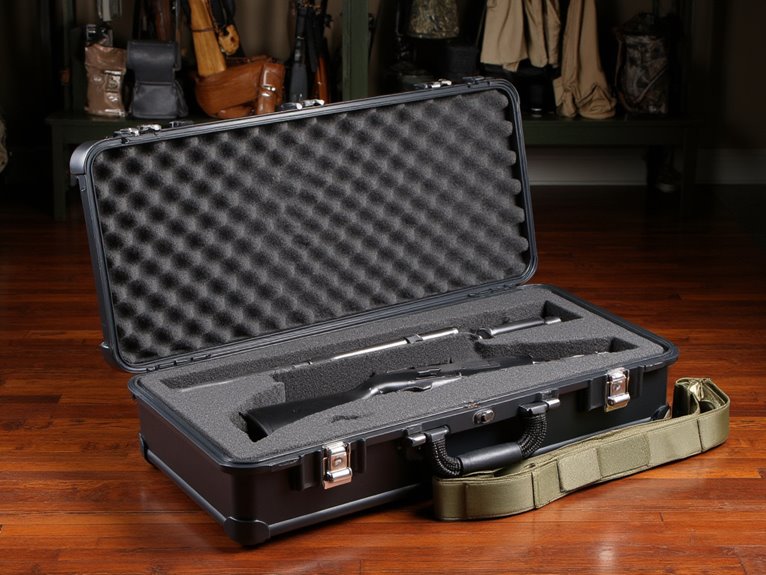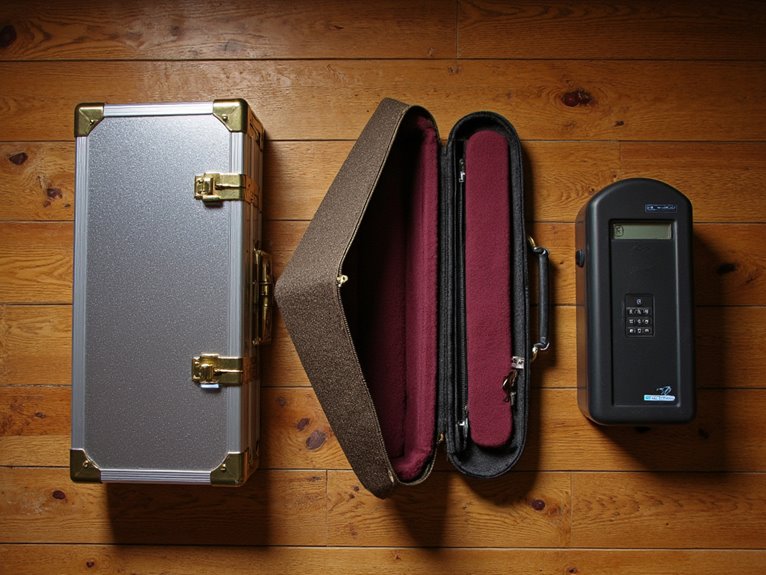How to Choose the Perfect Gun Case for Travel and Storage
You’ll need to choose between hard cases with impact-resistant polymers and soft cases with fabric padding, depending on your protection needs. Measure your firearm’s length, width, and height including all accessories, then add 2-4 inches for proper fit. Essential features include multi-layer foam padding, weatherproof seals, and lockable mechanisms for travel compliance. Consider portability options like padded handles and adjustable straps for transport comfort. This thorough selection process guarantees ideal protection and functionality for your specific requirements.
We are supported by our audience. When you purchase through links on our site, we may earn an affiliate commission, at no extra cost for you. Learn more. Last update on 5th January 2026 / Images from Amazon Product Advertising API.
Notable Insights
- Choose hard cases with reinforced locking points and watertight seals for superior protection against impacts, theft, and weather damage.
- Measure your firearm with all accessories and add 2-4 inches to ensure proper fit without pressure points or excessive movement.
- Look for multi-layer foam padding (1/2 to 1-inch thick) and custom-cut inserts to prevent weapon movement and absorb impacts.
- Select cases with padded handles, adjustable shoulder straps, and lockable mechanisms that comply with TSA travel regulations for firearms.
- Consider storage efficiency with vertical options, multi-compartment designs, and modular systems that accommodate growing collections while maintaining quick access.
Hard Cases vs. Soft Cases: Material Considerations for Maximum Protection
Every gun owner faces a fundamental choice when selecting protective storage: hard cases versus soft cases, each engineered with distinct materials that determine their protective capabilities.
Hard cases utilize high-impact plastics, molded polymers, or metal alloys with crush-proof outer shells. They feature reinforced locking points and watertight seals.
Hard cases feature crush-proof shells made from high-impact plastics, molded polymers, or metal alloys with reinforced locks and watertight seals.
Soft cases rely on durable fabrics like nylon or Cordura with foam padding for basic protection.
The durability comparison reveals significant differences. Hard cases withstand drops, impacts, and crushing forces that would compromise soft alternatives.
They resist punctures and environmental hazards effectively. Security features favor hard cases with TSA-compliant locking mechanisms and rigid construction that prevents unauthorized access.
Soft cases typically can’t accommodate locks and offer minimal theft deterrence. Many hard cases feature thick-walled construction with interlocking foam systems that provide superior firearm protection during transport. Soft cases are lighter weight, making them advantageous for hunters who need to carry their equipment over long distances. Additionally, hard cases often include wheels for easier transport when handling heavy or multiple firearms. Your choice depends on transport conditions and protection requirements.
Measuring Your Firearm and Selecting the Right Case Size
Before you can select the right case size, you’ll need precise measurements of your firearm’s length, width, and height including all mounted accessories.
These accurate measurements determine the minimum internal case dimensions required to protect your gun without causing damage from pressure or inadequate clearance. Adding an extra inch or two to your measurements provides space for easy placement and accommodates any future modifications to your firearm.
Understanding both your firearm’s exact dimensions and how they correspond to internal case specifications guarantees you’ll choose a case that provides proper protection while allowing easy insertion and removal. Consider whether you need scoped rifle cases to accommodate rifles with mounted optics that require additional clearance space.
Some cases are designed for rifles up to specific lengths, such as 49 inches long, so verifying your firearm’s total length against the case’s maximum capacity is essential for proper fit.
Accurate Firearm Measurements
Getting the right measurements isn’t just important-it’s essential for finding a gun case that’ll actually protect your firearm during transport and storage. Proper firearm dimensions determine case compatibility and regulatory compliance.
Start with overall length measurement techniques from barrel tip to buttstock end, including permanently attached devices. Use rigid measuring tools for accuracy to 1/8 inch. For barrel length, measure from breech face to muzzle, excluding removable attachments. This impacts compartment sizing requirements.
Measure length of pull from trigger center to recoil pad end. Account for adjustable stocks at your preferred setting.
Width and height measurements must include optics, scopes, and mounted accessories. These affect case closure and padding requirements.
Allow 0.5-1 inch buffer beyond actual dimensions for protective padding and easy closure.
Internal Case Dimensions
Success in firearm protection hinges on precise internal case measurements that match your weapon’s exact specifications. You’ll need dimensions stability to prevent equipment damage during transport.
Add 2-4 inches to your firearm’s total length for ideal fit. Scoped rifles require 3-4 extra inches, while competition firearms need 4-5 additional inches for specialized gear.
Measure your weapon’s widest point, including mounted accessories like scopes or bipods. Confirm adequate height clearance for trigger guards and raised sights.
Cases too large cause unnecessary shifting and potential scratches. Undersized cases create pressure points that damage your firearm’s structure.
Conduct a thorough compatibility assessment before purchasing. Consider permanently attached accessories when determining case requirements. Detachable components stored inside need separate space calculations.
Proper internal dimensions confirm effective locking mechanisms and retention systems function correctly.
Essential Protection Features for Safe Transport
You’ll need two critical protection features when transporting firearms: advanced padding systems and weather-resistant construction.
Advanced padding systems use multi-layer foam configurations, typically combining closed-cell foam densities of 2-4 pounds per cubic foot with convoluted surfaces that distribute impact forces across the firearm’s surface area.
Weather-resistant construction incorporates gasket-sealed designs with silicone or neoprene seals that maintain IP67 waterproof ratings, protecting your firearm from moisture infiltration during transport through varying environmental conditions.
For permanent home storage, consider fireproof waterproof safes that offer superior protection against disasters while maintaining secure access to your firearms.
Advanced Padding Systems
Protection isn’t just about having padding-it’s about having the right padding engineered for maximum impact absorption and firearm security.
Advanced cushioning technology utilizes high-density polyethylene (HDPE) or specialized foam materials that provide superior rigidity and shock absorption. You’ll find padding durability becomes critical during repeated use-premium cases feature 1/2 to 1-inch thick padding that withstands compression without losing effectiveness.
Multi-layer designs separate shock zones to prevent direct force transfer to your firearm.
Custom-cut foam inserts guarantee exact fit, eliminating weapon movement during transit. Shock-absorbing cores dissipate energy from drops and impacts, while reinforced contact points increase resistance during high-stress events. Look for cases with extra padding at corners and edges where direct impacts typically occur.
Non-slip interior surfaces minimize micro-movements and vibration damage.
Weather Resistant Construction
Even the most advanced padding systems won’t protect your firearm if moisture, dust, or debris infiltrates the case during transport. Weather resistant construction forms your first line of defense against environmental threats.
Weatherproof materials like robust polypropylene and high-impact polymers create impenetrable barriers. Rubber seals integrated into hard cases block water and dust ingress effectively. Sealing mechanisms include IPX-rated waterproof zippers and heavy-duty closures with moisture barriers.
| Component | Protection Level | Material | Performance |
|---|---|---|---|
| Exterior Shell | Waterproof/Dustproof | Polypropylene | Impact Resistant |
| Zipper System | IPX-Rated | Sealed Design | Rain Proof |
| Rubber Seals | Complete Seal | Weather Strip | Dust Barrier |
| Closure Latches | Secure Lock | ABS Plastic | Moisture Block |
Proper weatherproofing maintains internal dryness while preventing rust and corrosion that destroys firearms during extended storage or travel.
Portability Options for Comfortable Carrying

The right carrying system transforms a cumbersome gun case into a manageable piece of travel gear that won’t leave you exhausted before reaching your destination.
Carrying handles come in dual configurations with padded grips that reduce hand strain during extended transport. Reinforced construction withstands weights exceeding 50 pounds without failure.
Shoulder straps offer superior weight distribution through adjustable padded designs. Detachable straps provide flexibility between carrying methods, while non-slip surfaces prevent sliding during movement. Quick-release buckles expedite security checkpoint processing.
Backpack systems excel for rough terrain transport. Padded panels with adjustable chest and waist straps distribute loads effectively across your torso.
Weight trade-offs matter notably-soft cases weigh 2-4 pounds versus hard cases at 8-15 pounds. External pockets accommodate magazines, tools, and accessories without requiring separate bags.
Space-Efficient Storage Solutions for Home and Travel
Smart storage planning maximizes your available space while keeping gun cases accessible and protected.
Vertical storage solutions enhance floor space by using wall-mounted racks and pegboards designed for secure case mounting. Systems like Winchester Safes’ GunStiXX™ hold firearms upright with customizable lengths and damage-free materials.
Compact solutions include:
- Multi-compartment cases that eliminate separate storage needs
- Nestable lightweight designs that stack without excessive bulk
- Custom foam inserts that prevent movement and maximize safe space
Install adjustable shelving units with proper depth measurements for various case sizes. Label each shelf for quick identification.
Store cases vertically inside safes using door panel organizers made from heavy-duty canvas. Deploy modular storage systems that adapt as your collection grows, combining racks, shelves, and safes for maximum efficiency.
When planning your storage layout, prioritize quick access to frequently used cases while maintaining optimal environmental conditions for long-term firearm preservation.
Meeting Travel Regulations and Security Requirements
When traveling with firearms, compliance with federal regulations isn’t optional-it’s mandatory and carries serious legal consequences for violations.
Your case must meet strict travel regulations requiring hard-sided construction with lockable mechanisms. Firearms stay unloaded in checked baggage only. You’ll declare everything at check-in.
Security requirements demand non-TSA approved locks maintaining your sole access to contents. Choose cases with impact-resistant materials like reinforced polymer or aluminum. Internal foam prevents movement during transit. The case must fit your firearm snugly while providing tamper-evident security.
Research destination laws before departure. State and international regulations vary greatly. Keep permits accessible during travel.
Arrive early allowing extra processing time. Your case becomes the primary barrier between compliance and costly violations.
Look for cases with customizable foam interiors that allow you to create a precise fit for your specific firearm and accessories.
On a final note
You’ll need to balance protection, portability, and compliance when selecting your gun case. Hard cases offer superior impact resistance for air travel, while soft cases provide lightweight convenience for local transport. Measure your firearm’s exact dimensions and add 10% clearance for proper fit. Verify TSA compliance if flying, guarantee adequate foam padding protects critical components, and choose reinforced handles for heavy loads. Your specific use case determines the ideal material and feature combination.

